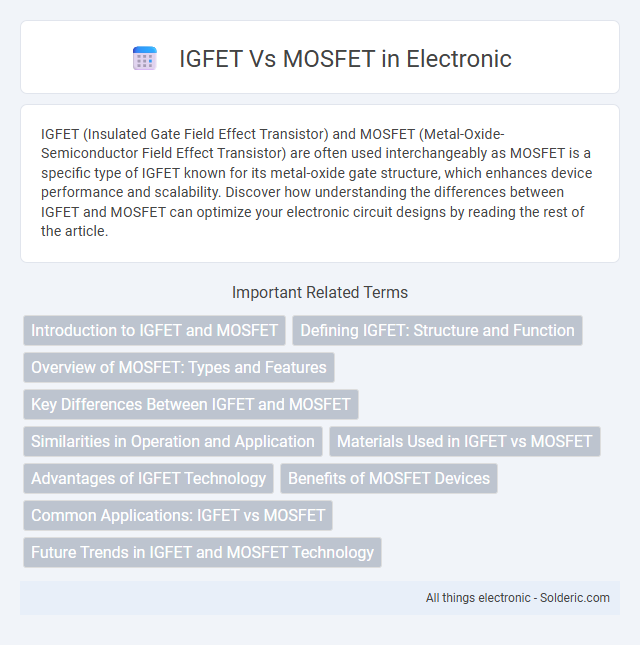IGFET (Insulated Gate Field Effect Transistor) and MOSFET (Metal-Oxide-Semiconductor Field Effect Transistor) are often used interchangeably as MOSFET is a specific type of IGFET known for its metal-oxide gate structure, which enhances device performance and scalability. Discover how understanding the differences between IGFET and MOSFET can optimize your electronic circuit designs by reading the rest of the article.
Comparison Table
| Feature | IGFET (Insulated Gate Field Effect Transistor) | MOSFET (Metal-Oxide-Semiconductor FET) |
|---|---|---|
| Definition | Field effect transistor with insulated gate controlling channel conductivity | Type of IGFET using metal-oxide layer as gate insulator |
| Gate Insulation | Insulated gate, can be various materials | Thin silicon dioxide (SiO2) oxide layer |
| Material | Varies; general FET category | Silicon semiconductor with metal gate and oxide insulator |
| Structure | Generic insulated gate structure | Specific metal-oxide-semiconductor gate stack |
| Usage | General term including MOSFET and others | Widely used in digital and analog circuits |
| Performance | Depends on insulation material and design | High input impedance, fast switching, low power |
| Applications | Broad usage in FET-based circuits | Microprocessors, memory chips, power electronics |
Introduction to IGFET and MOSFET
IGFET (Insulated-Gate Field-Effect Transistor) and MOSFET (Metal-Oxide-Semiconductor Field-Effect Transistor) are types of field-effect transistors widely used in electronic circuits for amplification and switching. MOSFET is the most common IGFET variant, characterized by its metal gate, oxide layer, and semiconductor substrate, offering high input impedance and fast switching speeds. Both devices function by controlling current flow through an electric field applied to the gate terminal, but MOSFETs dominate modern electronics due to their scalability and integration into CMOS technology.
Defining IGFET: Structure and Function
An IGFET (Insulated Gate Field Effect Transistor) is a type of MOSFET (Metal-Oxide-Semiconductor Field Effect Transistor) distinguished by its insulated gate structure that controls current flow through an electric field. The transistor consists of a semiconductor channel sandwiched between source and drain terminals, with a gate electrode separated by a thin oxide layer that modulates the channel conductivity without direct electrical contact. Understanding the IGFET's layered structure and gate insulation helps clarify its function and advantages in low-power and high-input impedance applications.
Overview of MOSFET: Types and Features
MOSFETs (Metal-Oxide-Semiconductor Field-Effect Transistors) are widely used semiconductor devices classified into two main types: n-channel (NMOS) and p-channel (PMOS), distinguished by their charge carriers. Key features include high input impedance, fast switching speeds, and scalability, making them essential in digital circuits and analog applications. Unlike IGFETs, the term MOSFET specifically highlights the metal-oxide gate structure that provides enhanced control over the channel conductivity.
Key Differences Between IGFET and MOSFET
IGFET (Insulated Gate Field Effect Transistor) and MOSFET (Metal-Oxide-Semiconductor Field Effect Transistor) differ primarily in their gate material and structure, with IGFET using an insulated gate without specifying the oxide layer, while MOSFET specifically incorporates a metal-oxide gate. MOSFETs offer superior switching speeds and lower power consumption due to their well-defined oxide layer, making them the preferred choice in digital and analog circuits. Your selection between IGFET and MOSFET depends on performance requirements, fabrication complexity, and application specificity.
Similarities in Operation and Application
IGFET and MOSFET both operate by controlling the conductivity of a semiconductor channel through an electric field applied via a gate terminal, enabling efficient switching and amplification in electronic circuits. They share similar applications in digital integrated circuits, analog amplifiers, and power electronics due to their high input impedance and fast switching speeds. Both transistors are essential in CMOS technology, forming the basis for modern microprocessors and memory devices.
Materials Used in IGFET vs MOSFET
IGFETs (Insulated Gate Field-Effect Transistors) and MOSFETs (Metal-Oxide-Semiconductor FETs) primarily differ in the materials used for their gate insulation and structure. IGFETs utilize an insulated gate, typically made of materials like silicon dioxide (SiO2) or silicon nitride (Si3N4), to prevent current flow between the gate and the channel. MOSFETs specifically incorporate a metal gate electrode combined with a thin oxide layer (usually SiO2) to enhance gate control and switching performance, allowing Your electronic devices to function efficiently at high speeds with low power consumption.
Advantages of IGFET Technology
IGFET technology offers advantages including lower power consumption and higher input impedance compared to traditional MOSFETs, making it ideal for low-noise amplification applications. Its ability to provide better control over channel conductivity results in improved device performance and reliability. You can benefit from IGFETs in integrated circuits where precision and energy efficiency are critical.
Benefits of MOSFET Devices
MOSFET devices offer superior switching speeds and higher input impedance compared to IGFETs, making them ideal for high-frequency and low-power applications. Their enhanced thermal stability and scalability enable efficient integration into modern digital circuits and power management systems. Choosing MOSFETs can significantly improve your circuit's performance and energy efficiency in advanced electronic designs.
Common Applications: IGFET vs MOSFET
IGFETs (Insulated Gate Field Effect Transistors) and MOSFETs (Metal-Oxide-Semiconductor FETs) are widely used in digital and analog circuits, but MOSFETs dominate in power amplification and switching applications due to their high electron mobility and fast switching speeds. IGFETs are commonly utilized in integrated circuits, such as microprocessors and memory devices, where their voltage-controlled operation allows for efficient signal modulation. Your choice between IGFET and MOSFET depends on specific application requirements, including frequency, power handling, and integration density.
Future Trends in IGFET and MOSFET Technology
Future trends in IGFET and MOSFET technology emphasize scaling down device dimensions to enhance speed, power efficiency, and integration density, driven by advancements in materials like high-k dielectrics and 2D semiconductors. Innovations in FinFET and gate-all-around (GAA) architectures improve electrostatic control, reducing leakage currents and enabling continued Moore's Law progression. Emerging applications in flexible electronics, quantum computing, and AI hardware accelerate research into novel IGFET and MOSFET designs tailored for high performance and low power consumption.
IGFET vs MOSFET Infographic

 solderic.com
solderic.com